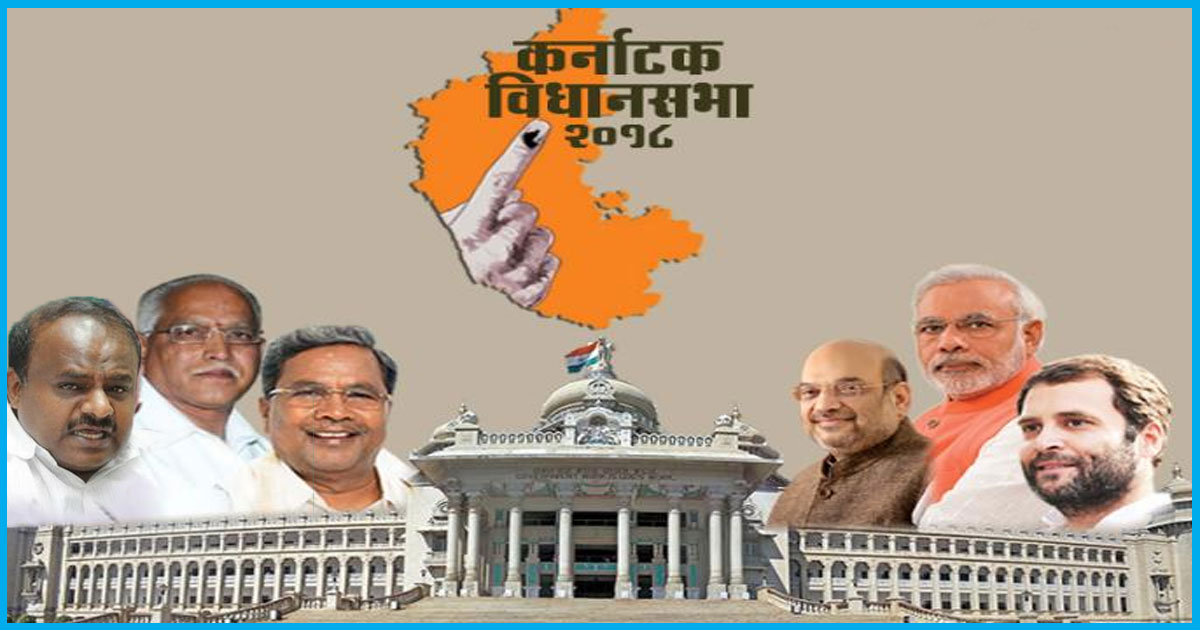Results Say Hung Assembly In Karnataka: Know What Has Happened So Far
15 May 2018 1:25 PM GMT
BJP emerged as the single largest party in Karnataka elections with 104 seats but failed to cross the halfway mark of 112 seats. The elections, held on May 12, were predicted by many as too close to call. However, as the constituency wise results came pouring in on Tuesday, INC surrendered its early lead and BJP came closer to grasping power, seeming they would get a complete majority. JD(S) leader, HD Kumaraswamy, won from both Ramanagaram and Channapatna constituencies and he is constitutionally bound to vacate one seat, thus making 111, the new majority mark.
As per latest data from the Election Commission of India, BJP has won 104 seats while incumbent INC could only manage 78 seats. Janata Dal (Secular) came in third with 37 seats, but a hung assembly seems to have turned things into their favour. MLA R Shankar who had contested as an Independent candidate has officialy given his support to BJP, thus increasing BJP’s tally to 105. INC did manage to get the highest vote share with 38% of total votes, closely followed by BJP. The voter turnout of 72.13% is the highest in the state since the 1952 assembly elections.

Elections were conducted for 222 out the total 224 assembly seats. ECI, in its notification issued on May 11, said that the polling in the constituency of Jayanagar had been adjourned “due to death of a candidate of a national party”, whereas the polling in Rajarajeshwari Nagar constituency is scheduled to take place on May 28. ECI took this decision after more than 9,700 voter id cards were seized from a flat in Rajarajeshwari Nagar area just two days prior to the election.
Parties in a race to stake their claim
When it became clear that no party is going to get a complete majority, INC extended formal support to JD(S). G. Parameshwara, President of the Karnataka Pradesh Congress Committee, spoke to the media: “We accept the mandate of the people. We bow our heads to the verdict. We don’t have numbers to form the government. The Congress has offered to support JD(S) to form government.” Senior INC leader Ghulam Nabi Azad added, “We had a telephonic conversation with Deve Gowda ji & Kumaraswamy. They have accepted our offer. Hopefully, we will be together.”
JD(S) accepted Congress’ support, and even after coming in third, the party seemed set to make their chosen candidate, HD Kumaraswamy, the next chief minister of Karnataka. JD(S) President Danish Ali said, ”We had always maintained that HD Kumaraswamy will be CM. As per results, we’re doing everything to keep BJP out of power. Congress has extended its support, we have accepted it. We will jointly go to meet Governor after 5.30 PM today.”
The exact nature of this post-poll coalition will be confirmed once party leaders successfully stake their claim to form the government in front of Governor Vajubhai Vala. A Congress party delegation led by G. Parameshwara was refused permission to meet the Governor in the afternoon. ANI reported that JD(S) leader Kumaraswamy had requested to meet the Governor at his residence between 5.30 pm and 6 pm today evening. As per reports, BJP leaders are seeking out the Governor to grant them a week’s time to prove their majority in the house.
On Wednesday morning, BJP leader BS Yeddyurappa met the Governor, and he remains upbeat about BJP’s chances to form the government. As uncertainty looms large, the allegations of ‘horse-trading’ MLAs’ have been made from all the three parties. JD(S) chief ministerial candidate Kumaraswamy accused BJP of trying to repeat “Operation Lotus,” referring to events in 2008 when at least 6 JD(S) and INC MLAs crossed over to BJP.
Role of the governor in case of a hung assembly
A governor of an Indian state can exercise his discretion when no party manages to win the requisite number of seats on its own. Conventionally, a governor can ask respective parties or coalitions to establish their majority in the house by way of a floor test. If no party or coalition stakes a claim, the party securing the highest number of seats is given first preference by the governor, followed by a pre-poll alliance of parties and lastly, any post-poll alliances may be asked if till then the assembly remains hung.
However, in last year’s Goa Assembly elections, Congress secured the highest number of seats and BJP came second, with 17 and 13 seats respectively. Goa faced a hung assembly as no party managed to secure the needed 22 seats. At that time, INC did not stake a claim even though it had the maximum number of seats. This gave BJP an opportunity to form a post-poll alliance and they subsequently formed the government in Goa after winning the floor test.
INC filed a plea against the governor’s decision to invite BJP’s post-poll alliance in Goa. The Supreme Court upheld the choice of the governor and suggested, during a hearing on 14th March 2017, that in case of a hung assembly it would be unreasonable to invite the party with the most seats if there exists a post-poll coalition with the requisite majority.
It now depends on governor Vajubhai Vala whether he would follow convention or go along with SC’s last year suggestion. Vala has decades of experience of India’s political scenario, having had an illustrious career in Gujarat’s BJP leadership. Vala had vacated his Rajkot II seat in Gujarat Assembly in 2001 enabling Modi to win his first Assembly election. Vala was appointed Karnataka governor in September 2014, soon after the power transition at centre.
 All section
All section














